1989 FORD FIESTA wheel bolts
[x] Cancel search: wheel boltsPage 142 of 296
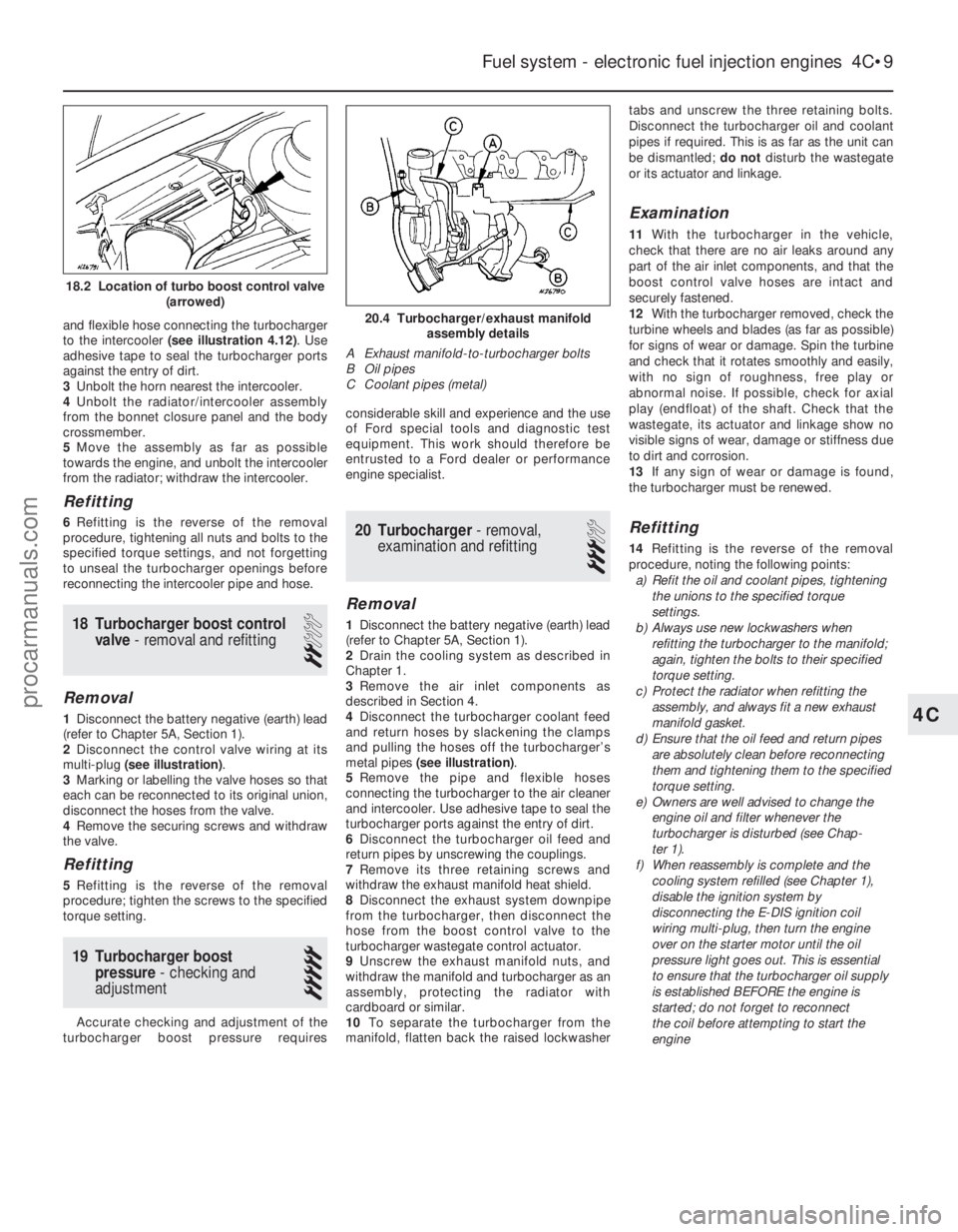
and flexible hose connecting the turbocharger
to the intercooler (see illustration 4.12) . Use
adhesive tape to seal the turbocharger ports
against the entry of dirt.
3 Unbolt the horn nearest the intercooler.
4 Unbolt the radiator/intercooler assembly
from the bonnet closure panel and the body
crossmember.
5 Move the assembly as far as possible
towards the engine, and unbolt the intercooler
from the radiator; withdraw the intercooler.
Refitting
6 Refitting is the reverse of the removal
procedure, tightening all nuts and bolts to the
specified torque settings, and not forgetting
to unseal the turbocharger openings before
reconnecting the intercooler pipe and hose.
18 Turbocharger boost control valve - removal and refitting
2
Removal
1Disconnect the battery negative (earth) lead
(refer to Chapter 5A, Section 1).
2 Disconnect the control valve wiring at its
multi-plug (see illustration) .
3 Marking or labelling the valve hoses so that
each can be reconnected to its original union,
disconnect the hoses from the valve.
4 Remove the securing screws and withdraw
the valve.
Refitting
5 Refitting is the reverse of the removal
procedure; tighten the screws to the specified
torque setting.
19 Turbocharger boost pressure - checking and
adjustment
5
Accurate checking and adjustment of the
turbocharger boost pressure requires considerable skill and experience and the use
of Ford special tools and diagnostic test
equipment. This work should therefore be
entrusted to a Ford dealer or performance
engine specialist.
20 Turbocharger
- removal,
examination and refitting
3
Removal
1 Disconnect the battery negative (earth) lead
(refer to Chapter 5A, Section 1).
2 Drain the cooling system as described in
Chapter 1.
3 Remove the air inlet components as
described in Section 4.
4 Disconnect the turbocharger coolant feed
and return hoses by slackening the clamps
and pulling the hoses off the turbocharger’s
metal pipes (see illustration) .
5 Remove the pipe and flexible hoses
connecting the turbocharger to the air cleaner
and intercooler. Use adhesive tape to seal the
turbocharger ports against the entry of dirt.
6 Disconnect the turbocharger oil feed and
return pipes by unscrewing the couplings.
7 Remove its three retaining screws and
withdraw the exhaust manifold heat shield.
8 Disconnect the exhaust system downpipe
from the turbocharger, then disconnect the
hose from the boost control valve to the
turbocharger wastegate control actuator.
9 Unscrew the exhaust manifold nuts, and
withdraw the manifold and turbocharger as an
assembly, protecting the radiator with
cardboard or similar.
10 To separate the turbocharger from the
manifold, flatten back the raised lockwasher tabs and unscrew the three retaining bolts.
Disconnect the turbocharger oil and coolant
pipes if required. This is as far as the unit can
be dismantled;
do notdisturb the wastegate
or its actuator and linkage.
Examination
11 With the turbocharger in the vehicle,
check that there are no air leaks around any
part of the air inlet components, and that the
boost control valve hoses are intact and
securely fastened.
12 With the turbocharger removed, check the
turbine wheels and blades (as far as possible)
for signs of wear or damage. Spin the turbine
and check that it rotates smoothly and easily,
with no sign of roughness, free play or
abnormal noise. If possible, check for axial
play (endfloat) of the shaft. Check that the
wastegate, its actuator and linkage show no
visible signs of wear, damage or stiffness due
to dirt and corrosion.
13 If any sign of wear or damage is found,
the turbocharger must be renewed.
Refitting
14 Refitting is the reverse of the removal
procedure, noting the following points: a) Refit the oil and coolant pipes, tightening
the unions to the specified torque
settings.
b) Always use new lockwashers when
refitting the turbocharger to the manifold;
again, tighten the bolts to their specified
torque setting.
c) Protect the radiator when refitting the
assembly, and always fit a new exhaust
manifold gasket.
d) Ensure that the oil feed and return pipes
are absolutely clean before reconnecting
them and tightening them to the specified
torque setting.
e) Owners are well advised to change the engine oil and filter whenever the
turbocharger is disturbed (see Chap-
ter 1).
f) When reassembly is complete and the
cooling system refilled (see Chapter 1),
disable the ignition system by
disconnecting the E-DIS ignition coil
wiring multi-plug, then turn the engine
over on the starter motor until the oil
pressure light goes out. This is essential
to ensure that the turbocharger oil supply
is established BEFORE the engine is
started; do not forget to reconnect
the coil before attempting to start the
engine
Fuel system - electronic fuel injection engines 4C•9
20.4 Turbocharger/exhaust manifold assembly details
A Exhaust manifold-to-turbocharger bolts
B Oil pipes
C Coolant pipes (metal)
4C
1595Ford Fiesta Remake
18.2 Location of turbo boost control valve (arrowed)
procarmanuals.com
http://vnx.su
Page 158 of 296
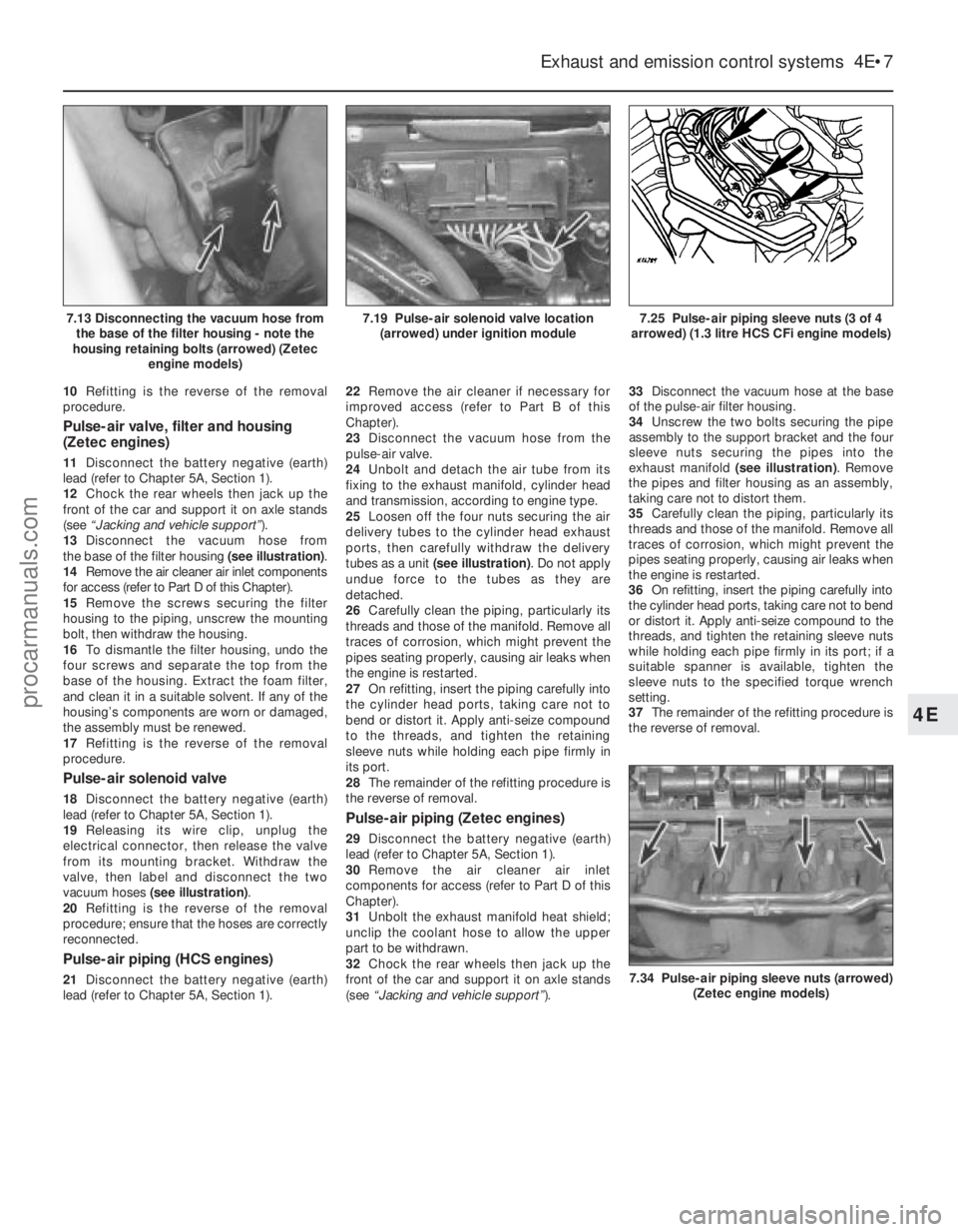
10Refitting is the reverse of the removal
procedure.
Pulse-air valve, filter and housing
(Zetec engines)
11 Disconnect the battery negative (earth)
lead (refer to Chapter 5A, Section 1).
12 Chock the rear wheels then jack up the
front of the car and support it on axle stands
(see “Jacking and vehicle support” ).
13 Disconnect the vacuum hose from
the base of the filter housing (see illustration).
14 Remove the air cleaner air inlet components
for access (refer to Part D of this Chapter).
15 Remove the screws securing the filter
housing to the piping, unscrew the mounting
bolt, then withdraw the housing.
16 To dismantle the filter housing, undo the
four screws and separate the top from the
base of the housing. Extract the foam filter,
and clean it in a suitable solvent. If any of the
housing’s components are worn or damaged,
the assembly must be renewed.
17 Refitting is the reverse of the removal
procedure.
Pulse-air solenoid valve
18 Disconnect the battery negative (earth)
lead (refer to Chapter 5A, Section 1).
19 Releasing its wire clip, unplug the
electrical connector, then release the valve
from its mounting bracket. Withdraw the
valve, then label and disconnect the two
vacuum hoses (see illustration) .
20 Refitting is the reverse of the removal
procedure; ensure that the hoses are correctly
reconnected.
Pulse-air piping (HCS engines)
21 Disconnect the battery negative (earth)
lead (refer to Chapter 5A, Section 1). 22
Remove the air cleaner if necessary for
improved access (refer to Part B of this
Chapter).
23 Disconnect the vacuum hose from the
pulse-air valve.
24 Unbolt and detach the air tube from its
fixing to the exhaust manifold, cylinder head
and transmission, according to engine type.
25 Loosen off the four nuts securing the air
delivery tubes to the cylinder head exhaust
ports, then carefully withdraw the delivery
tubes as a unit (see illustration) . Do not apply
undue force to the tubes as they are
detached.
26 Carefully clean the piping, particularly its
threads and those of the manifold. Remove all
traces of corrosion, which might prevent the
pipes seating properly, causing air leaks when
the engine is restarted.
27 On refitting, insert the piping carefully into
the cylinder head ports, taking care not to
bend or distort it. Apply anti-seize compound
to the threads, and tighten the retaining
sleeve nuts while holding each pipe firmly in
its port.
28 The remainder of the refitting procedure is
the reverse of removal.
Pulse-air piping (Zetec engines)
29 Disconnect the battery negative (earth)
lead (refer to Chapter 5A, Section 1).
30 Remove the air cleaner air inlet
components for access (refer to Part D of this
Chapter).
31 Unbolt the exhaust manifold heat shield;
unclip the coolant hose to allow the upper
part to be withdrawn.
32 Chock the rear wheels then jack up the
front of the car and support it on axle stands
(see “Jacking and vehicle support” ).33
Disconnect the vacuum hose at the base
of the pulse-air filter housing.
34 Unscrew the two bolts securing the pipe
assembly to the support bracket and the four
sleeve nuts securing the pipes into the
exhaust manifold (see illustration). Remove
the pipes and filter housing as an assembly,
taking care not to distort them.
35 Carefully clean the piping, particularly its
threads and those of the manifold. Remove all
traces of corrosion, which might prevent the
pipes seating properly, causing air leaks when
the engine is restarted.
36 On refitting, insert the piping carefully into
the cylinder head ports, taking care not to bend
or distort it. Apply anti-seize compound to the
threads, and tighten the retaining sleeve nuts
while holding each pipe firmly in its port; if a
suitable spanner is available, tighten the
sleeve nuts to the specified torque wrench
setting.
37 The remainder of the refitting procedure is
the reverse of removal.
Exhaust and emission control systems 4E•7
7.25 Pulse-air piping sleeve nuts (3 of 4
arrowed) (1.3 litre HCS CFi engine models)7.19 Pulse-air solenoid valve location (arrowed) under ignition module7.13 Disconnecting the vacuum hose fromthe base of the filter housing - note the
housing retaining bolts (arrowed) (Zetec engine models)
7.34 Pulse-air piping sleeve nuts (arrowed)
(Zetec engine models)
4E
1595Ford Fiesta Remakeprocarmanuals.com
http://vnx.su
Page 163 of 296
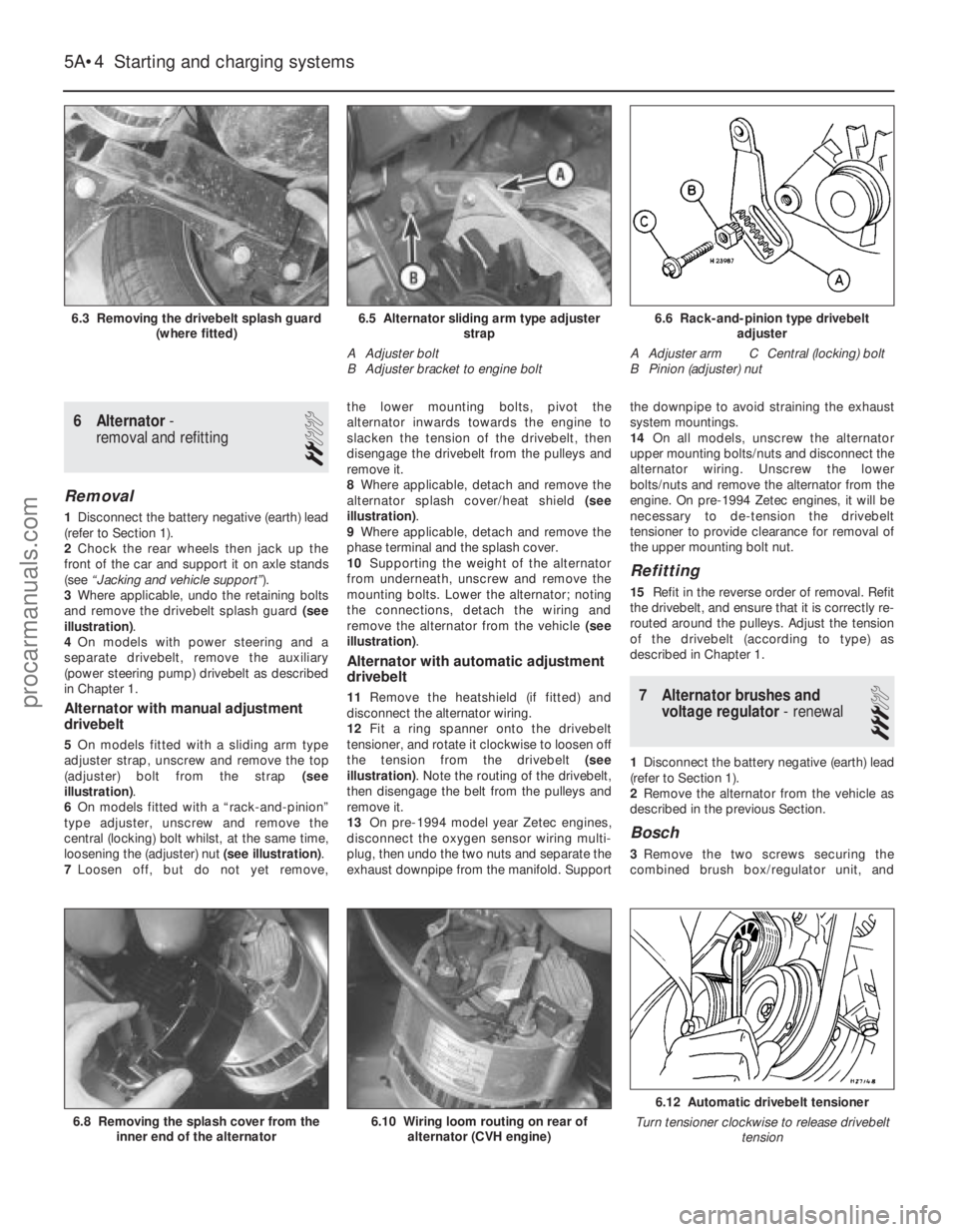
6 Alternator-
removal and refitting
2
Removal
1 Disconnect the battery negative (earth) lead
(refer to Section 1).
2 Chock the rear wheels then jack up the
front of the car and support it on axle stands
(see “Jacking and vehicle support” ).
3 Where applicable, undo the retaining bolts
and remove the drivebelt splash guard (see
illustration) .
4 On models with power steering and a
separate drivebelt, remove the auxiliary
(power steering pump) drivebelt as described
in Chapter 1.
Alternator with manual adjustment
drivebelt
5 On models fitted with a sliding arm type
adjuster strap, unscrew and remove the top
(adjuster) bolt from the strap (see
illustration) .
6 On models fitted with a “rack-and-pinion”
type adjuster, unscrew and remove the
central (locking) bolt whilst, at the same time,
loosening the (adjuster) nut (see illustration).
7 Loosen off, but do not yet remove, the lower mounting bolts, pivot the
alternator inwards towards the engine to
slacken the tension of the drivebelt, then
disengage the drivebelt from the pulleys and
remove it.
8
Where applicable, detach and remove the
alternator splash cover/heat shield (see
illustration) .
9 Where applicable, detach and remove the
phase terminal and the splash cover.
10 Supporting the weight of the alternator
from underneath, unscrew and remove the
mounting bolts. Lower the alternator; noting
the connections, detach the wiring and
remove the alternator from the vehicle (see
illustration) .
Alternator with automatic adjustment
drivebelt
11Remove the heatshield (if fitted) and
disconnect the alternator wiring.
12 Fit a ring spanner onto the drivebelt
tensioner, and rotate it clockwise to loosen off
the tension from the drivebelt (see
illustration) . Note the routing of the drivebelt,
then disengage the belt from the pulleys and
remove it.
13 On pre-1994 model year Zetec engines,
disconnect the oxygen sensor wiring multi-
plug, then undo the two nuts and separate the
exhaust downpipe from the manifold. Support the downpipe to avoid straining the exhaust
system mountings.
14
On all models, unscrew the alternator
upper mounting bolts/nuts and disconnect the
alternator wiring. Unscrew the lower
bolts/nuts and remove the alternator from the
engine. On pre-1994 Zetec engines, it will be
necessary to de-tension the drivebelt
tensioner to provide clearance for removal of
the upper mounting bolt nut.
Refitting
15 Refit in the reverse order of removal. Refit
the drivebelt, and ensure that it is correctly re-
routed around the pulleys. Adjust the tension
of the drivebelt (according to type) as
described in Chapter 1.
7 Alternator brushes and voltage regulator - renewal
3
1Disconnect the battery negative (earth) lead
(refer to Section 1).
2 Remove the alternator from the vehicle as
described in the previous Section.
Bosch
3 Remove the two screws securing the
combined brush box/regulator unit, and
5A•4 Starting and charging systems
6.12 Automatic drivebelt tensioner
Turn tensioner clockwise to release drivebelt tension
6.10 Wiring loom routing on rear ofalternator (CVH engine)6.8 Removing the splash cover from the inner end of the alternator
6.6 Rack-and-pinion type drivebelt adjuster
A Adjuster arm C Central (locking) bolt
B Pinion (adjuster) nut6.5 Alternator sliding arm type adjuster strap
A Adjuster bolt
B Adjuster bracket to engine bolt6.3 Removing the drivebelt splash guard (where fitted)
1595Ford Fiesta Remakeprocarmanuals.com
http://vnx.su
Page 166 of 296
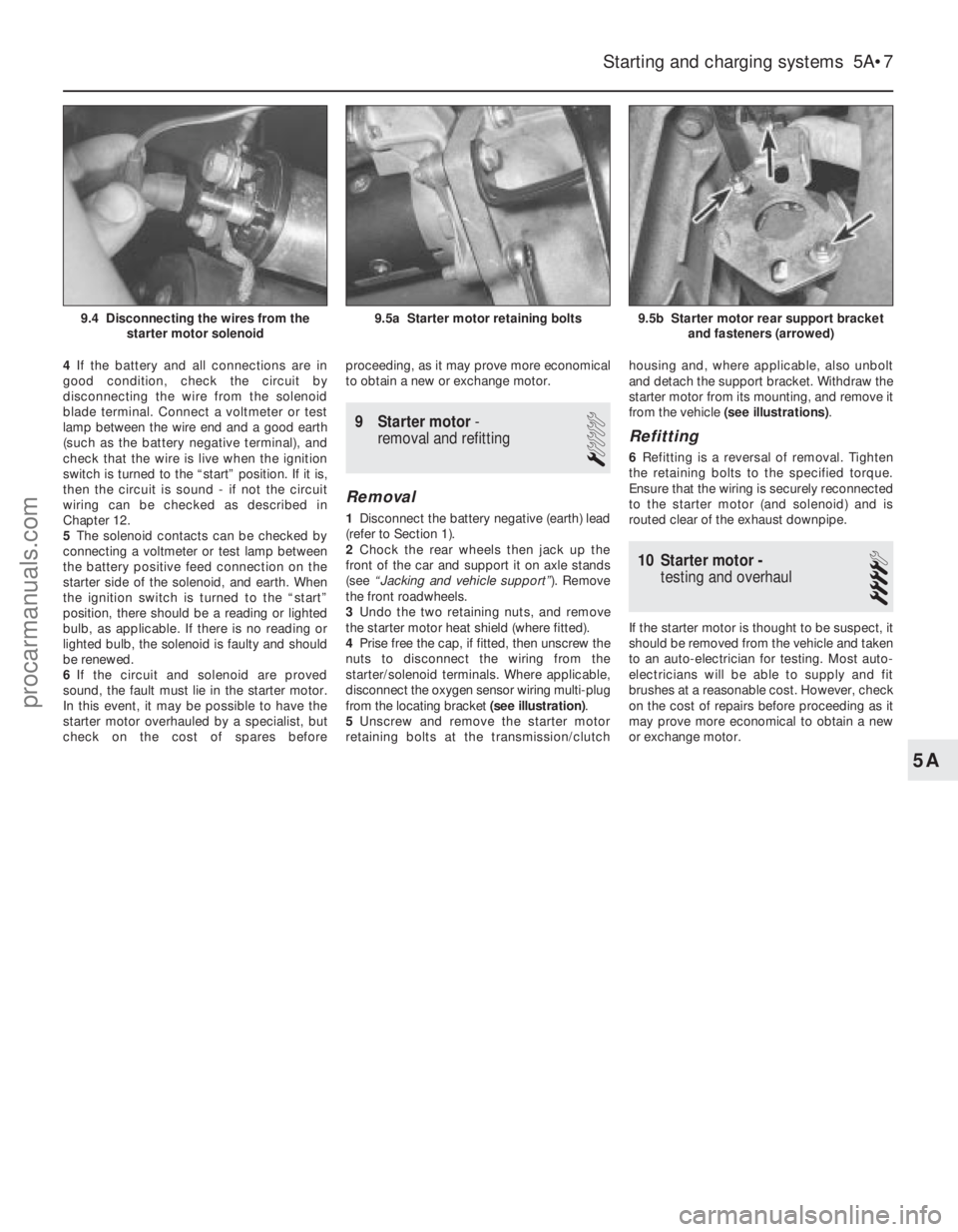
4If the battery and all connections are in
good condition, check the circuit by
disconnecting the wire from the solenoid
blade terminal. Connect a voltmeter or test
lamp between the wire end and a good earth
(such as the battery negative terminal), and
check that the wire is live when the ignition
switch is turned to the “start” position. If it is,
then the circuit is sound - if not the circuit
wiring can be checked as described in
Chapter 12.
5 The solenoid contacts can be checked by
connecting a voltmeter or test lamp between
the battery positive feed connection on the
starter side of the solenoid, and earth. When
the ignition switch is turned to the “start”
position, there should be a reading or lighted
bulb, as applicable. If there is no reading or
lighted bulb, the solenoid is faulty and should
be renewed.
6 If the circuit and solenoid are proved
sound, the fault must lie in the starter motor.
In this event, it may be possible to have the
starter motor overhauled by a specialist, but
check on the cost of spares before proceeding, as it may prove more economical
to obtain a new or exchange motor.
9 Starter motor
-
removal and refitting
1
Removal
1 Disconnect the battery negative (earth) lead
(refer to Section 1).
2 Chock the rear wheels then jack up the
front of the car and support it on axle stands
(see “Jacking and vehicle support” ). Remove
the front roadwheels.
3 Undo the two retaining nuts, and remove
the starter motor heat shield (where fitted).
4 Prise free the cap, if fitted, then unscrew the
nuts to disconnect the wiring from the
starter/solenoid terminals. Where applicable,
disconnect the oxygen sensor wiring multi-plug
from the locating bracket (see illustration).
5 Unscrew and remove the starter motor
retaining bolts at the transmission/clutch housing and, where applicable, also unbolt
and detach the support bracket. Withdraw the
starter motor from its mounting, and remove it
from the vehicle
(see illustrations) .
Refitting
6Refitting is a reversal of removal. Tighten
the retaining bolts to the specified torque.
Ensure that the wiring is securely reconnected
to the starter motor (and solenoid) and is
routed clear of the exhaust downpipe.
10 Starter motor - testing and overhaul
4
If the starter motor is thought to be suspect, it
should be removed from the vehicle and taken
to an auto-electrician for testing. Most auto-
electricians will be able to supply and fit
brushes at a reasonable cost. However, check
on the cost of repairs before proceeding as it
may prove more economical to obtain a new
or exchange motor.
Starting and charging systems 5A•7
9.5b Starter motor rear support bracket
and fasteners (arrowed)9.5a Starter motor retaining bolts9.4 Disconnecting the wires from thestarter motor solenoid
5A
1595Ford Fiesta Remakeprocarmanuals.com
http://vnx.su
Page 177 of 296
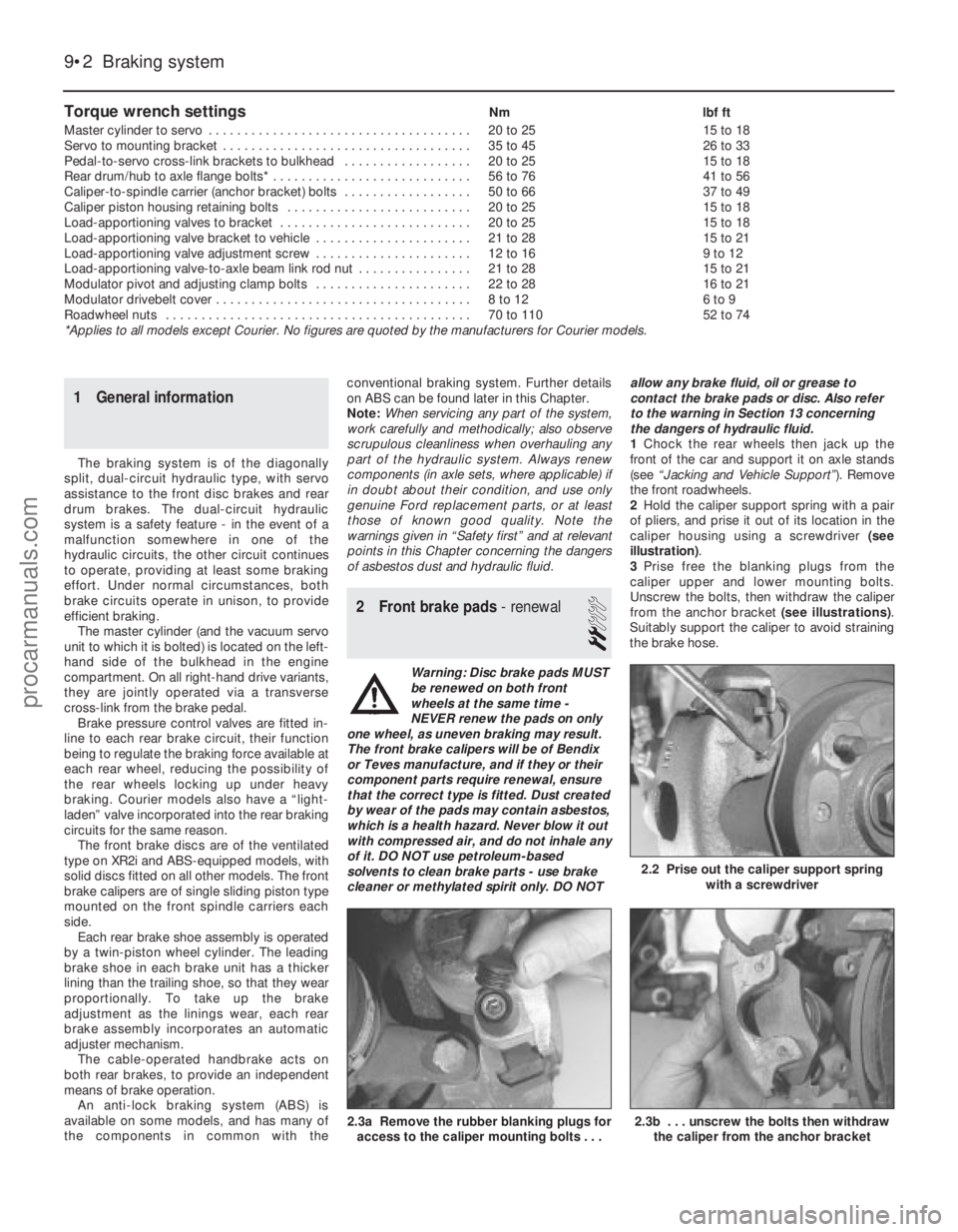
1 General information
The braking system is of the diagonally
split, dual-circuit hydraulic type, with servo
assistance to the front disc brakes and rear
drum brakes. The dual-circuit hydraulic
system is a safety feature - in the event of a
malfunction somewhere in one of the
hydraulic circuits, the other circuit continues
to operate, providing at least some braking
effort. Under normal circumstances, both
brake circuits operate in unison, to provide
efficient braking.
The master cylinder (and the vacuum servo
unit to which it is bolted) is located on the left-
hand side of the bulkhead in the engine
compartment. On all right-hand drive variants,
they are jointly operated via a transverse
cross-link from the brake pedal.
Brake pressure control valves are fitted in-
line to each rear brake circuit, their function
being to regulate the braking force available at
each rear wheel, reducing the possibility of
the rear wheels locking up under heavy
braking. Courier models also have a “light-
laden” valve incorporated into the rear braking
circuits for the same reason. The front brake discs are of the ventilated
type on XR2i and ABS-equipped models, with
solid discs fitted on all other models. The front
brake calipers are of single sliding piston type
mounted on the front spindle carriers each
side. Each rear brake shoe assembly is operated
by a twin-piston wheel cylinder. The leading
brake shoe in each brake unit has a thicker
lining than the trailing shoe, so that they wear
proportionally. To take up the brake
adjustment as the linings wear, each rear
brake assembly incorporates an automatic
adjuster mechanism. The cable-operated handbrake acts on
both rear brakes, to provide an independent
means of brake operation. An anti-lock braking system (ABS) is
available on some models, and has many of
the components in common with the conventional braking system. Further details
on ABS can be found later in this Chapter.
Note:
When servicing any part of the system,
work carefully and methodically; also observe
scrupulous cleanliness when overhauling any
part of the hydraulic system. Always renew
components (in axle sets, where applicable) if
in doubt about their condition, and use only
genuine Ford replacement parts, or at least
those of known good quality. Note the
warnings given in “Safety first” and at relevant
points in this Chapter concerning the dangers
of asbestos dust and hydraulic fluid.
2 Front brake pads - renewal
2
Warning: Disc brake pads MUST
be renewed on both front
wheels at the same time -
NEVER renew the pads on only
one wheel, as uneven braking may result.
The front brake calipers will be of Bendix
or Teves manufacture, and if they or their
component parts require renewal, ensure
that the correct type is fitted. Dust created
by wear of the pads may contain asbestos,
which is a health hazard. Never blow it out
with compressed air, and do not inhale any
of it. DO NOT use petroleum-based
solvents to clean brake parts - use brake
cleaner or methylated spirit only. DO NOT allow any brake fluid, oil or grease to
contact the brake pads or disc. Also refer
to the warning in Section 13 concerning
the dangers of hydraulic fluid.
1
Chock the rear wheels then jack up the
front of the car and support it on axle stands
(see “Jacking and Vehicle Support” ). Remove
the front roadwheels.
2 Hold the caliper support spring with a pair
of pliers, and prise it out of its location in the
caliper housing using a screwdriver (see
illustration) .
3 Prise free the blanking plugs from the
caliper upper and lower mounting bolts.
Unscrew the bolts, then withdraw the caliper
from the anchor bracket (see illustrations).
Suitably support the caliper to avoid straining
the brake hose.
Torque wrench settingsNm lbf ft
Master cylinder to servo . . . . . . . . . . . . . . . . . . . . . . . . . . . . . . . . . . . .\
. 20 to 25 15 to 18
Servo to mounting bracket . . . . . . . . . . . . . . . . . . . . . . . . . . . . . . . . . . . 35 to 45 26 to 33
Pedal-to-servo cross-link brackets to bulkhead . . . . . . . . . . . . . . . . . . 20 to 25 15 to 18
Rear drum/hub to axle flange bolts* . . . . . . . . . . . . . . . . . . . . . . . . . . . . 56 to 76 41 to 56
Caliper-to-spindle carrier (anchor bracket) bolts . . . . . . . . . . . . . . . . . . 50 to 66 37 to 49
Caliper piston housing retaining bolts . . . . . . . . . . . . . . . . . . . . . . . . . . 20 to 25 15 to 18
Load-apportioning valves to bracket . . . . . . . . . . . . . . . . . . . . . . . . . . . 20 to 25 15 to 18
Load-apportioning valve bracket to vehicle . . . . . . . . . . . . . . . . . . . . . . 21 to 28 15 to 21
Load-apportioning valve adjustment screw . . . . . . . . . . . . . . . . . . . . . . 12 to 16 9 to 12
Load-apportioning valve-to-axle beam link rod nut . . . . . . . . . . . . . . . . 21 to 28 15 to 21
Modulator pivot and adjusting clamp bolts . . . . . . . . . . . . . . . . . . . . . . 22 to 28 16 to 21
Modulator drivebelt cover . . . . . . . . . . . . . . . . . . . . . . . . . . . . . . . . . . . .\
8 to 12 6 to 9
Roadwheel nuts . . . . . . . . . . . . . . . . . . . . . . . . . . . . . . . . . . . .\
. . . . . . . 70 to 110 52 to 74
*Applies to all models except Courier. No figures are quoted by the manu\
facturers for Courier models.
9•2 Braking system
2.3b . . . unscrew the bolts then withdraw the caliper from the anchor bracket2.3a Remove the rubber blanking plugs foraccess to the caliper mounting bolts . . .
2.2 Prise out the caliper support spring with a screwdriver
1595Ford Fiesta Remakeprocarmanuals.com
http://vnx.su
Page 178 of 296
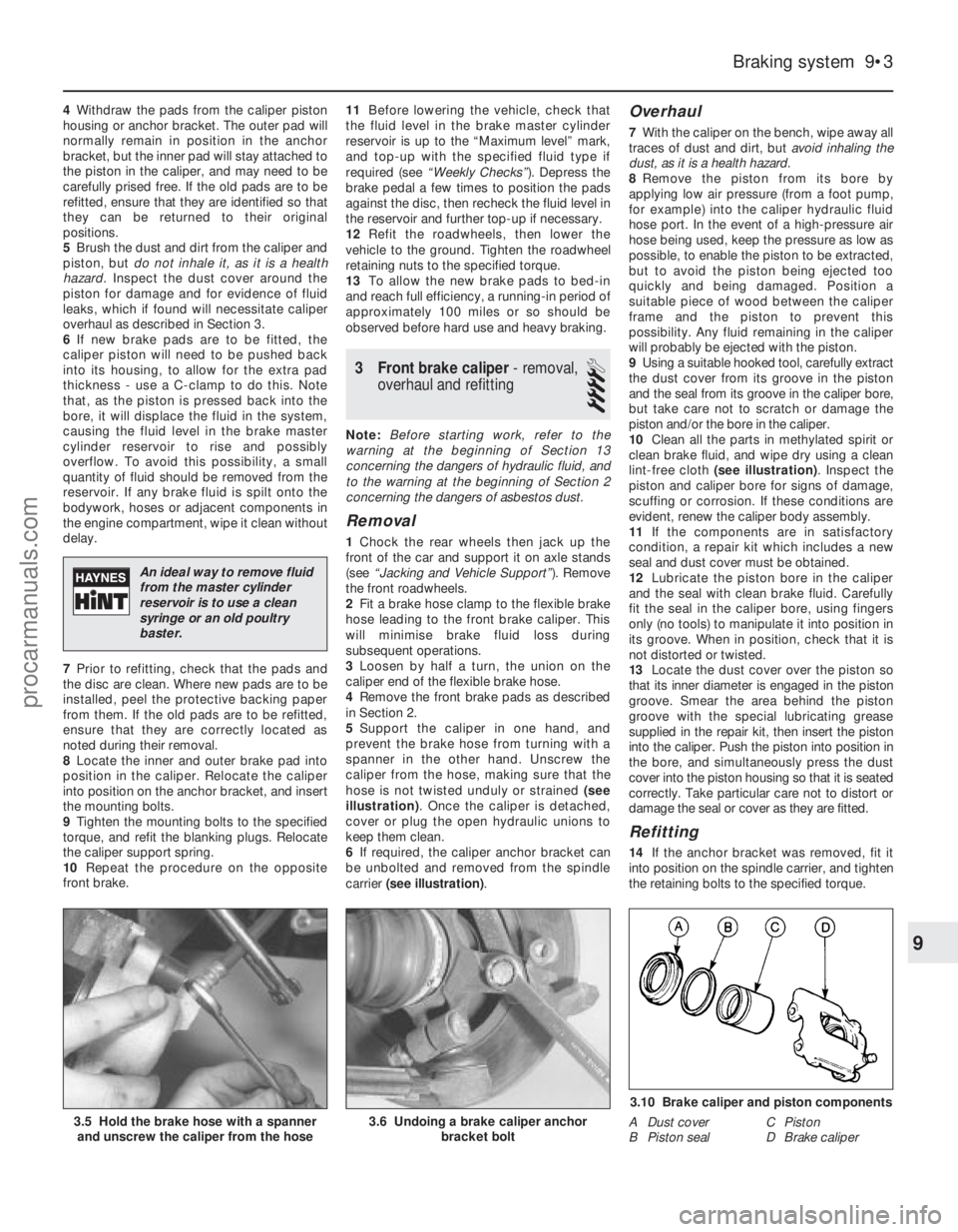
4Withdraw the pads from the caliper piston
housing or anchor bracket. The outer pad will
normally remain in position in the anchor
bracket, but the inner pad will stay attached to
the piston in the caliper, and may need to be
carefully prised free. If the old pads are to be
refitted, ensure that they are identified so that
they can be returned to their original
positions.
5 Brush the dust and dirt from the caliper and
piston, but do not inhale it, as it is a health
hazard . Inspect the dust cover around the
piston for damage and for evidence of fluid
leaks, which if found will necessitate caliper
overhaul as described in Section 3.
6 If new brake pads are to be fitted, the
caliper piston will need to be pushed back
into its housing, to allow for the extra pad
thickness - use a C-clamp to do this. Note
that, as the piston is pressed back into the
bore, it will displace the fluid in the system,
causing the fluid level in the brake master
cylinder reservoir to rise and possibly
overflow. To avoid this possibility, a small
quantity of fluid should be removed from the
reservoir. If any brake fluid is spilt onto the
bodywork, hoses or adjacent components in
the engine compartment, wipe it clean without
delay.
7 Prior to refitting, check that the pads and
the disc are clean. Where new pads are to be
installed, peel the protective backing paper
from them. If the old pads are to be refitted,
ensure that they are correctly located as
noted during their removal.
8 Locate the inner and outer brake pad into
position in the caliper. Relocate the caliper
into position on the anchor bracket, and insert
the mounting bolts.
9 Tighten the mounting bolts to the specified
torque, and refit the blanking plugs. Relocate
the caliper support spring.
10 Repeat the procedure on the opposite
front brake. 11
Before lowering the vehicle, check that
the fluid level in the brake master cylinder
reservoir is up to the “Maximum level” mark,
and top-up with the specified fluid type if
required (see “Weekly Checks” ). Depress the
brake pedal a few times to position the pads
against the disc, then recheck the fluid level in
the reservoir and further top-up if necessary.
12 Refit the roadwheels, then lower the
vehicle to the ground. Tighten the roadwheel
retaining nuts to the specified torque.
13 To allow the new brake pads to bed-in
and reach full efficiency, a running-in period of
approximately 100 miles or so should be
observed before hard use and heavy braking.
3 Front brake caliper - removal,
overhaul and refitting
4
Note: Before starting work, refer to the
warning at the beginning of Section 13
concerning the dangers of hydraulic fluid, and
to the warning at the beginning of Section 2
concerning the dangers of asbestos dust.
Removal
1 Chock the rear wheels then jack up the
front of the car and support it on axle stands
(see “Jacking and Vehicle Support” ). Remove
the front roadwheels.
2 Fit a brake hose clamp to the flexible brake
hose leading to the front brake caliper. This
will minimise brake fluid loss during
subsequent operations.
3 Loosen by half a turn, the union on the
caliper end of the flexible brake hose.
4 Remove the front brake pads as described
in Section 2.
5 Support the caliper in one hand, and
prevent the brake hose from turning with a
spanner in the other hand. Unscrew the
caliper from the hose, making sure that the
hose is not twisted unduly or strained (see
illustration) . Once the caliper is detached,
cover or plug the open hydraulic unions to
keep them clean.
6 If required, the caliper anchor bracket can
be unbolted and removed from the spindle
carrier (see illustration) .
Overhaul
7With the caliper on the bench, wipe away all
traces of dust and dirt, but avoid inhaling the
dust, as it is a health hazard .
8 Remove the piston from its bore by
applying low air pressure (from a foot pump,
for example) into the caliper hydraulic fluid
hose port. In the event of a high-pressure air
hose being used, keep the pressure as low as
possible, to enable the piston to be extracted,
but to avoid the piston being ejected too
quickly and being damaged. Position a
suitable piece of wood between the caliper
frame and the piston to prevent this
possibility. Any fluid remaining in the caliper
will probably be ejected with the piston.
9 Using a suitable hooked tool, carefully extract
the dust cover from its groove in the piston
and the seal from its groove in the caliper bore,
but take care not to scratch or damage the
piston and/or the bore in the caliper.
10 Clean all the parts in methylated spirit or
clean brake fluid, and wipe dry using a clean
lint-free cloth (see illustration) . Inspect the
piston and caliper bore for signs of damage,
scuffing or corrosion. If these conditions are
evident, renew the caliper body assembly.
11 If the components are in satisfactory
condition, a repair kit which includes a new
seal and dust cover must be obtained.
12 Lubricate the piston bore in the caliper
and the seal with clean brake fluid. Carefully
fit the seal in the caliper bore, using fingers
only (no tools) to manipulate it into position in
its groove. When in position, check that it is
not distorted or twisted.
13 Locate the dust cover over the piston so
that its inner diameter is engaged in the piston
groove. Smear the area behind the piston
groove with the special lubricating grease
supplied in the repair kit, then insert the piston
into the caliper. Push the piston into position in
the bore, and simultaneously press the dust
cover into the piston housing so that it is seated
correctly. Take particular care not to distort or
damage the seal or cover as they are fitted.
Refitting
14 If the anchor bracket was removed, fit it
into position on the spindle carrier, and tighten
the retaining bolts to the specified torque.
Braking system 9•3
3.10 Brake caliper and piston components
A Dust cover C Piston
B Piston seal D Brake caliper
3.6 Undoing a brake caliper anchor bracket bolt3.5 Hold the brake hose with a spannerand unscrew the caliper from the hose
9
1595Ford Fiesta Remake
An ideal way to remove fluidfrom the master cylinder
reservoir is to use a clean
syringe or an old poultry
baster.
procarmanuals.com
http://vnx.su
Page 179 of 296
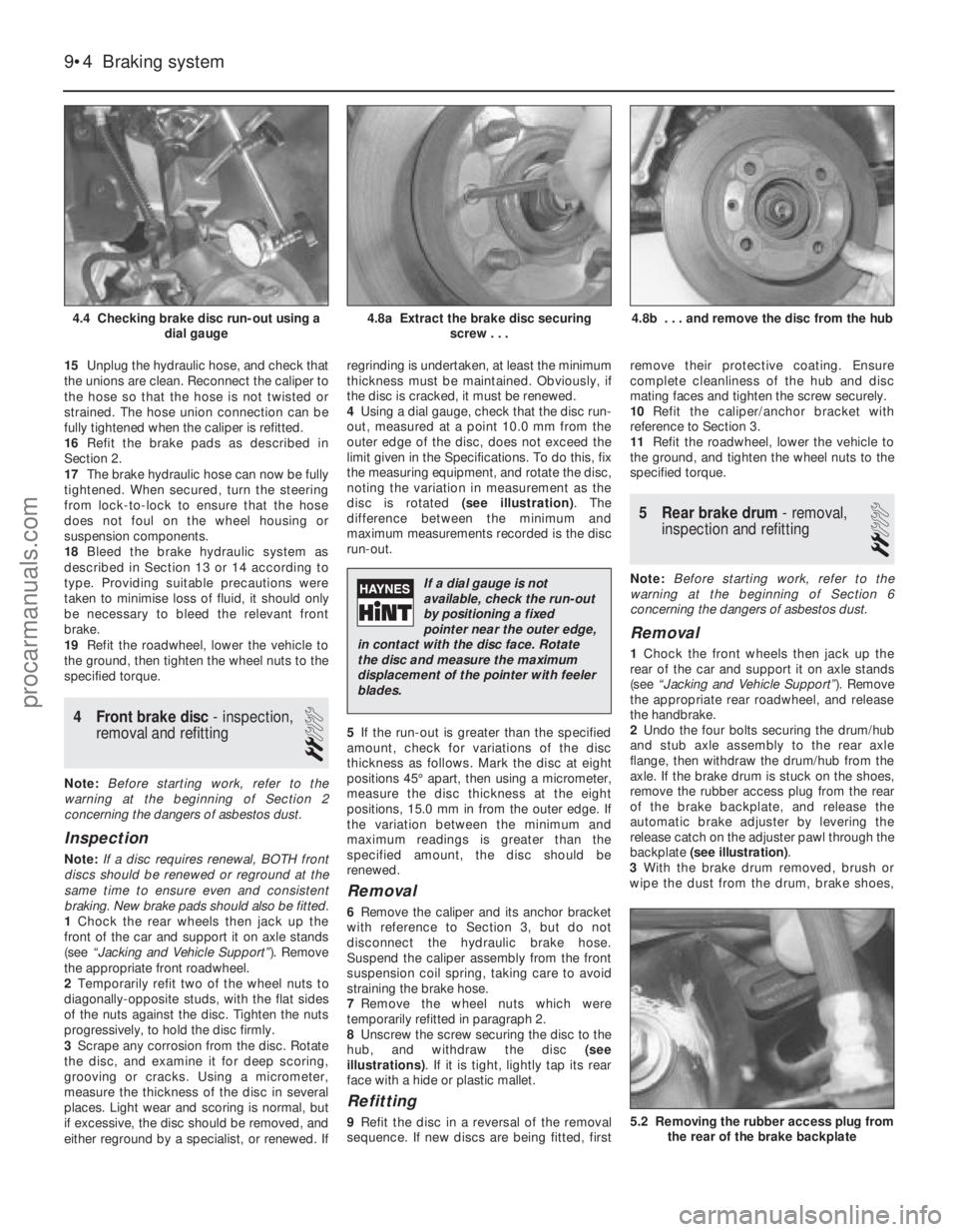
15Unplug the hydraulic hose, and check that
the unions are clean. Reconnect the caliper to
the hose so that the hose is not twisted or
strained. The hose union connection can be
fully tightened when the caliper is refitted.
16 Refit the brake pads as described in
Section 2.
17 The brake hydraulic hose can now be fully
tightened. When secured, turn the steering
from lock-to-lock to ensure that the hose
does not foul on the wheel housing or
suspension components.
18 Bleed the brake hydraulic system as
described in Section 13 or 14 according to
type. Providing suitable precautions were
taken to minimise loss of fluid, it should only
be necessary to bleed the relevant front
brake.
19 Refit the roadwheel, lower the vehicle to
the ground, then tighten the wheel nuts to the
specified torque.
4 Front brake disc - inspection,
removal and refitting
2
Note: Before starting work, refer to the
warning at the beginning of Section 2
concerning the dangers of asbestos dust.
Inspection
Note: If a disc requires renewal, BOTH front
discs should be renewed or reground at the
same time to ensure even and consistent
braking. New brake pads should also be fitted.
1 Chock the rear wheels then jack up the
front of the car and support it on axle stands
(see “Jacking and Vehicle Support” ). Remove
the appropriate front roadwheel.
2 Temporarily refit two of the wheel nuts to
diagonally-opposite studs, with the flat sides
of the nuts against the disc. Tighten the nuts
progressively, to hold the disc firmly.
3 Scrape any corrosion from the disc. Rotate
the disc, and examine it for deep scoring,
grooving or cracks. Using a micrometer,
measure the thickness of the disc in several
places. Light wear and scoring is normal, but
if excessive, the disc should be removed, and
either reground by a specialist, or renewed. If regrinding is undertaken, at least the minimum
thickness must be maintained. Obviously, if
the disc is cracked, it must be renewed.
4
Using a dial gauge, check that the disc run-
out, measured at a point 10.0 mm from the
outer edge of the disc, does not exceed the
limit given in the Specifications. To do this, fix
the measuring equipment, and rotate the disc,
noting the variation in measurement as the
disc is rotated (see illustration). The
difference between the minimum and
maximum measurements recorded is the disc
run-out.
5 If the run-out is greater than the specified
amount, check for variations of the disc
thickness as follows. Mark the disc at eight
positions 45° apart, then using a micrometer,
measure the disc thickness at the eight
positions, 15.0 mm in from the outer edge. If
the variation between the minimum and
maximum readings is greater than the
specified amount, the disc should be
renewed.
Removal
6 Remove the caliper and its anchor bracket
with reference to Section 3, but do not
disconnect the hydraulic brake hose.
Suspend the caliper assembly from the front
suspension coil spring, taking care to avoid
straining the brake hose.
7 Remove the wheel nuts which were
temporarily refitted in paragraph 2.
8 Unscrew the screw securing the disc to the
hub, and withdraw the disc (see
illustrations) . If it is tight, lightly tap its rear
face with a hide or plastic mallet.
Refitting
9 Refit the disc in a reversal of the removal
sequence. If new discs are being fitted, first remove their protective coating. Ensure
complete cleanliness of the hub and disc
mating faces and tighten the screw securely.
10
Refit the caliper/anchor bracket with
reference to Section 3.
11 Refit the roadwheel, lower the vehicle to
the ground, and tighten the wheel nuts to the
specified torque.
5 Rear brake drum - removal,
inspection and refitting
2
Note: Before starting work, refer to the
warning at the beginning of Section 6
concerning the dangers of asbestos dust.
Removal
1 Chock the front wheels then jack up the
rear of the car and support it on axle stands
(see “Jacking and Vehicle Support” ). Remove
the appropriate rear roadwheel, and release
the handbrake.
2 Undo the four bolts securing the drum/hub
and stub axle assembly to the rear axle
flange, then withdraw the drum/hub from the
axle. If the brake drum is stuck on the shoes,
remove the rubber access plug from the rear
of the brake backplate, and release the
automatic brake adjuster by levering the
release catch on the adjuster pawl through the
backplate (see illustration) .
3 With the brake drum removed, brush or
wipe the dust from the drum, brake shoes,
9•4 Braking system
5.2 Removing the rubber access plug from
the rear of the brake backplate
4.8b . . . and remove the disc from the hub4.8a Extract the brake disc securing screw . . .4.4 Checking brake disc run-out using a dial gauge
1595Ford Fiesta Remake
If a dial gauge is not
available, check the run-out
by positioning a fixed
pointer near the outer edge,
in contact with the disc face. Rotate
the disc and measure the maximum
displacement of the pointer with feeler
blades.
procarmanuals.com
http://vnx.su
Page 180 of 296
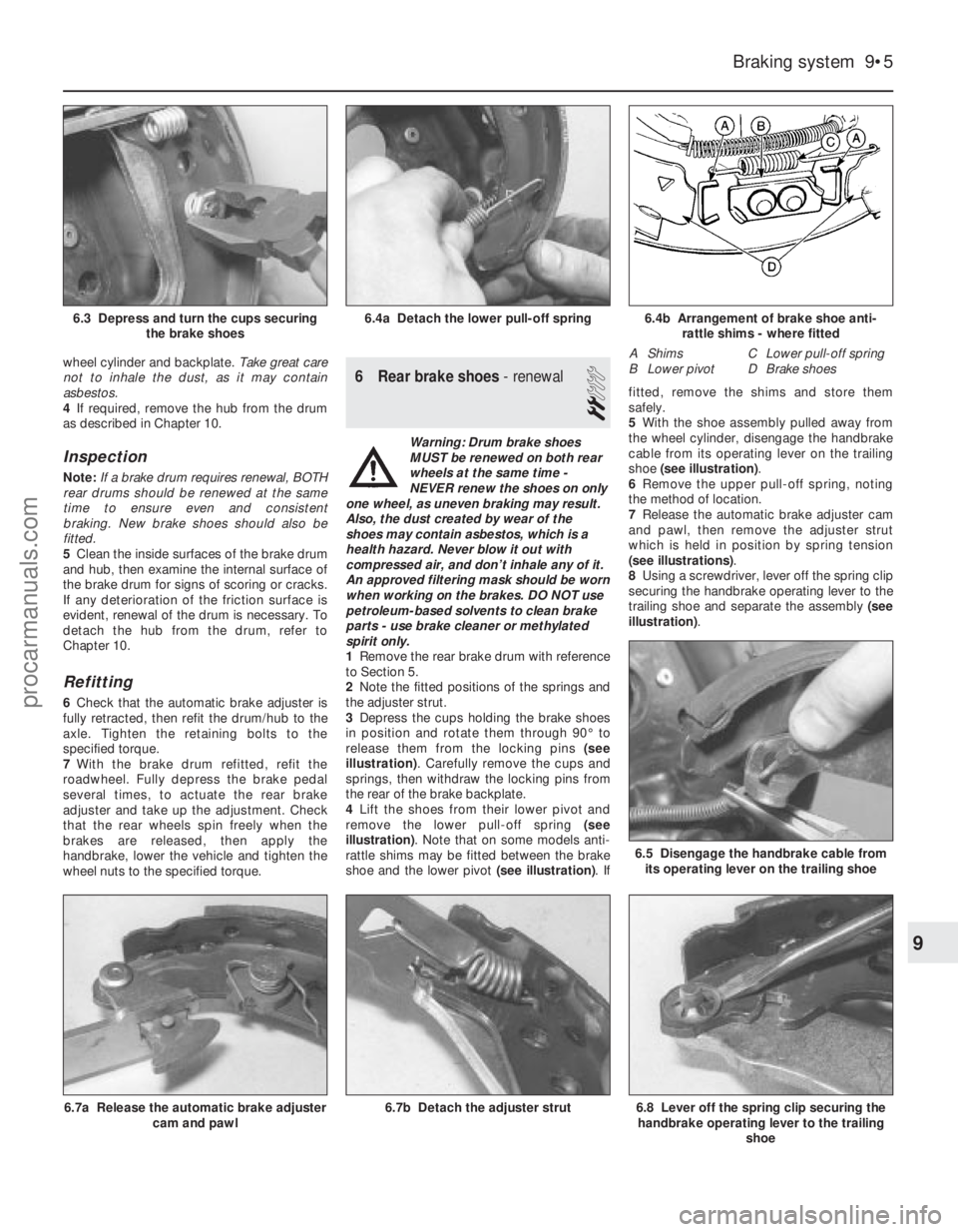
wheel cylinder and backplate. Take great care
not to inhale the dust, as it may contain
asbestos.
4 If required, remove the hub from the drum
as described in Chapter 10.
Inspection
Note: If a brake drum requires renewal, BOTH
rear drums should be renewed at the same
time to ensure even and consistent
braking. New brake shoes should also be
fitted.
5 Clean the inside surfaces of the brake drum
and hub, then examine the internal surface of
the brake drum for signs of scoring or cracks.
If any deterioration of the friction surface is
evident, renewal of the drum is necessary. To
detach the hub from the drum, refer to
Chapter 10.
Refitting
6 Check that the automatic brake adjuster is
fully retracted, then refit the drum/hub to the
axle. Tighten the retaining bolts to the
specified torque.
7 With the brake drum refitted, refit the
roadwheel. Fully depress the brake pedal
several times, to actuate the rear brake
adjuster and take up the adjustment. Check
that the rear wheels spin freely when the
brakes are released, then apply the
handbrake, lower the vehicle and tighten the
wheel nuts to the specified torque.
6 Rear brake shoes - renewal
2
Warning: Drum brake shoes
MUST be renewed on both rear
wheels at the same time -
NEVER renew the shoes on only
one wheel, as uneven braking may result.
Also, the dust created by wear of the
shoes may contain asbestos, which is a
health hazard. Never blow it out with
compressed air, and don’t inhale any of it.
An approved filtering mask should be worn
when working on the brakes. DO NOT use
petroleum-based solvents to clean brake
parts - use brake cleaner or methylated
spirit only.
1 Remove the rear brake drum with reference
to Section 5.
2 Note the fitted positions of the springs and
the adjuster strut.
3 Depress the cups holding the brake shoes
in position and rotate them through 90° to
release them from the locking pins (see
illustration) . Carefully remove the cups and
springs, then withdraw the locking pins from
the rear of the brake backplate.
4 Lift the shoes from their lower pivot and
remove the lower pull-off spring (see
illustration) . Note that on some models anti-
rattle shims may be fitted between the brake
shoe and the lower pivot (see illustration). Iffitted, remove the shims and store them
safely.
5
With the shoe assembly pulled away from
the wheel cylinder, disengage the handbrake
cable from its operating lever on the trailing
shoe (see illustration) .
6 Remove the upper pull-off spring, noting
the method of location.
7 Release the automatic brake adjuster cam
and pawl, then remove the adjuster strut
which is held in position by spring tension
(see illustrations) .
8 Using a screwdriver, lever off the spring clip
securing the handbrake operating lever to the
trailing shoe and separate the assembly (see
illustration) .
Braking system 9•5
6.4b Arrangement of brake shoe anti-
rattle shims - where fitted
A Shims C Lower pull-off spring
B Lower pivot D Brake shoes
6.5 Disengage the handbrake cable from its operating lever on the trailing shoe
6.4a Detach the lower pull-off spring6.3 Depress and turn the cups securing the brake shoes
6.8 Lever off the spring clip securing thehandbrake operating lever to the trailing
shoe6.7b Detach the adjuster strut6.7a Release the automatic brake adjustercam and pawl
9
1595Ford Fiesta Remakeprocarmanuals.com
http://vnx.su